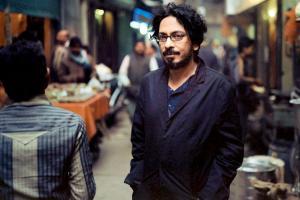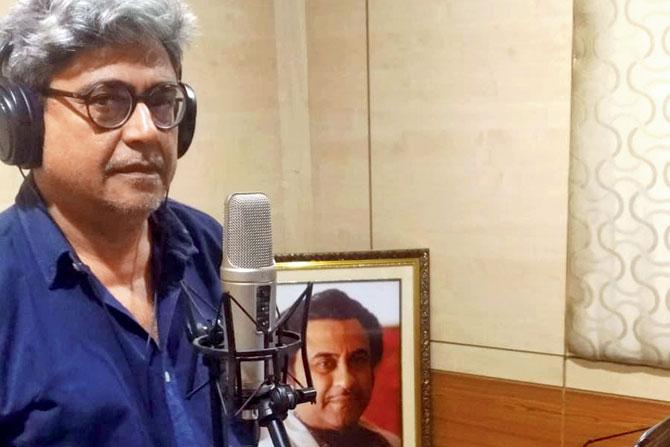For his first exhibition of radio plays, artist Sarnath Banerjee is listening to the stories of people from beyond the grave

Sarnath Banerjee. Pic Courtesy of Hemant Sareen
Sarnath Banerjee is keeping his ear not only to the ground, but what's six feet under. For Spectral Times, his new exhibition at Bhau Daji Lad, the writer of five acclaimed graphic novels has conducted mock interviews with those who see dead people. Over a phone interview, in a rather sexy voice, he tells us why he's going to focus on radio plays going forward.
How did Spectral Times come about?
I tell ghost stories to my son every night. We have a djinn encyclopaedia. The ghosts are based in Kolkata, Delhi, Karachi, Mumbai, and I find it quite easy to talk about reality through these djinns. I associate these djinns with a mohalla or a fish market or a clothes shop. With them, you can even navigate through the class system, talk about trade, about politics.
ADVERTISEMENT

Ruchir Joshi is one of the voices in the exhibition
What happened with the Mumbai project was an extension of that. These are mock interviews, recreated interviews, with people who have had spectral experiences. These spectral experiences happen all around Mumbai. Like behind Asiatic Library: 'Shelfon ke peeche, kitabon ke peeche, mujhe ek iblis dikhayi diya. I saw the devil between the shelves.' Or, something appears out of Powai Lake in the night. It's all told as if it's normal reportage.
The normality of the narrative makes it the most plausible. When I started thinking about it, I realised we live in a society where - with our intelligence and our norms - we can find an explanation for anything. All the horrible things we do, we have an explanation, often a religious one. But, there are certain things, which are not resolved. All the things you try to dabao [bury] come back to you in the form of ghosts. That's the central principle of denial: of denying the reality, of denying the truth, of denying political realities, of denying that your city has just been taken over by a bunch of hooligans. It's an anthropological idea. Possession and ghosts are basically re-visitors of unanswered questions.
How many stories are a part of this? And have you used different voices?
Thirteen. I have used the voice of theatre people, filmmakers, some trained, some untrained, some just because their voice is something I had in mind when I wrote the story. I'm a great champion of stories being told orally. I have taken voices from theatre, of people who were active in the 1970s and '80s. I had to travel to Mumbai, Delhi, Kolkata, Berlin to collect voices. It's basically like Phool Khile Hain Gulshan Gulshan, except my Tabassum is a bit dark. My Tabassum is asking strange questions. And the people who are answering are not Shammi Kapoor, but non-celebrities who are sinister. I am the voice of Bijis Bari. He's a tonal reporter: he doesn't want to get information, he wants to get the tone.
He works for this obscure fortnightly called Spectral Times. When you go through the exhibition, you'll come to know that Spectral Times is basically about a post-fact, post-belief world. If you back up [a claim] with emotion, it's better than fact. My character is an ex-fact checker. He realised that, 'Boss, there's no [need]. My job is defunct. Nobody needs that kind of hardcore fact. They just want emotion, ki, this falana chief minister has put 2,000 toilets in some village." The fact that those 2,000 toilets don't have any plumbing, or that the anganwadi workers have to carry human shit around, is another question. So, basically no one is into truth anymore; it's all about mythology. [Scholar] Sunil Khilnani - I'm a great fan of his - said this to me, 'Indians understand themselves through myth.' That's why you see so much mythological stuff among bestsellers. You go to a bookshop, and all you find is Nandan Nilekani's biography ad nauseam or you find some myth of Mithila.
You've mentioned that radio plays are "the nearest to telling a story in person." How do you plan to engage with the medium going forward?
This is my first big radio project, and it's going to be radio from now on. I'm going to focus on radio for a long time. I personally think radio is a visual medium, because you can conjure that particular evening in Mumbai. You can talk about that feeling of listlessness, of walking around the streets of Andheri.
If you just write down all the things you're doing, you can create a very rich visual world. I'm also pushing myself into doing radio comics, in which the narrative is of comics in radio, and you put drawings in it. I want to see how it works. At Bhau Daji Lad, I also want to create this radio salon, like you walk into a bar and a story is being told to you dramatically. You sit in a dark corner and curl around your whisky like a king cobra, and listen to the story of Shehri Adamkhor.
When: February 23 to May 14
Where: Bhau Daji Lad Museum, 91 A, Rani Baug, Byculla East
Entry: Rs 10
Catch up on all the latest Mumbai news, crime news, current affairs, and also a complete guide on Mumbai from food to things to do and events across the city here. Also download the new mid-day Android and iOS apps to get latest updates
 Subscribe today by clicking the link and stay updated with the latest news!" Click here!
Subscribe today by clicking the link and stay updated with the latest news!" Click here!







